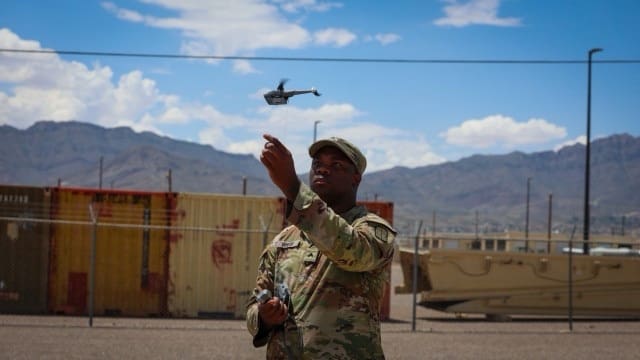
Fort Bliss, TX – If you’ve seen any footage from the ongoing war in Ukraine, odds are it was video that came from a drone. As the war has expanded since it began in 2022, so too have the usage of drones. The need for armies to reliably gather intelligence, spot dangers, and target enemies without putting Soldiers’ lives at risk has become a paramount concern.
Enter Soldier Borne Sensor, a program under Program Executive Office (PEO) Soldier with the mission of providing Soldiers with an effective Unmanned Aerial System (UAS) aimed to increase situational awareness while reducing detection risk.
After years of progress, the latest iteration of the Soldier Borne Sensor is now officially in Soldiers’ hands.
For three days, Soldiers of the 90th Sustainment Brigade, as part of the Joint Task Force – Southern Border, packed into a hot warehouse less than five miles from the southern border to train with the newly fielded Soldier Borne Sensor reconnaissance drone. The training involved two days of in-class learning of every function and feature, and one day of hands-on field experience learning to fly the drone.
The other units who participated in this training as part of the Joint Task Force were the 2nd Stryker Brigade Combat Team, part of the 4th Infantry Division, and the 89th Military Police Brigade.
This iteration of the Soldier Borne Sensor is an improvement in just about every regard possible from its predecessor. It has a much longer battery life, more durable frame, and a greater operating range.
All of those and other upgrades come wrapped up in one user-friendly reconnaissance drone built from the ground up with Soldiers in mind. It was that high functionality and ease of use that Soldiers took notice of and praised the most.
“It’s super easy to fly,” said one Sergeant who took part in the fielding. “I didn’t expect it to be as simple as it was. It’s definitely something you can pick up in 15 to 20 minutes.”
“On a basis level of being able to get the drone in the air and doing whatever you need to do, it’s very simple and user friendly,” a second Sergeant said. “It’s a great system that I would love to see implemented more… I would love to see these at a squad level, or one per fire team.”
One Soldier who had never flown drones before this training said the system was “very user friendly and easy to pick up and learn.”
As previously mentioned, this version of the Soldier Borne Sensor comes packed with many unique features and systems, all designed to increase a Soldier’s lethality and situational awareness.
And each Soldier there seemed to have a feature they liked the best.
“I liked the zipline feature,” one Soldier reported back. “You can just pick one point and be like ‘hey I want you to go from where you’re at now to this point’… and it will go from the point you’re at now to the point you set. Plus, you can pan the camera and it doesn’t matter which way you face it will keep going to that point you set.”
“The most impressive feature I saw was the different camera features,” said another Soldier. “I could see as clear as day as I can now, but it can also go to different versions of thermal which I found very impressive for how compact the device is.”
This iteration of the Soldier Borne Sensor comes equipped with an improved, high-resolution camera that can alternate between normal view, low-light, black-hot, white-hot, and thermal views at the push of a button.
Unlike previous iterations, which had its daytime and nighttime cameras separated into two different drones, requiring Soldiers to carry more weight, the latest version of the Soldier Borne Sensor wraps all these improvements into one drone.
“For me, the number one feature that I love is fly-to-home,” said one Staff Sergeant. “You’re the beacon for the drone. Instead of manually trying to control the drone to follow you, you set yourself as home.”
More than a few Soldiers had fun testing this feature out, as they paced around the training area with their drone following them wherever they went with no input on the Soldiers’ part.
Overall, the latest iteration of the Soldier Borne Sensor promises to be a valuable tool in the arsenal of our men and women in uniform.
As with all things PEO Soldier, the Soldier Borne Sensor program will only improve further as it learns from and incorporates feedback directly from Soldiers. That feedback at the first fielding has been overwhelmingly positive.
“I have nothing bad to say about the system,” said one Soldier when asked to summarize his time learning about the Soldier Borne Sensor. “It’s extremely versatile and it’s definitely a great asset to have.”
“This is probably going to be the greatest asset to both missions at home and abroad,” said another Soldier. “Instead of sending the actual Soldier in harm’s way, why not use the asset that doesn’t cost the life of an actual Soldier? I think it’s going to be a really good investment. It’s probably going to be the best investment for units, recon, signal, infantry, land survey… I think this piece of equipment checks all the boxes.”
By Zachary Montanaro
Both comments and pings are currently closed.
Read the full article here



